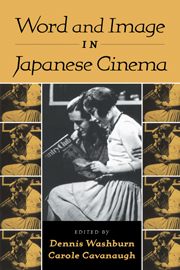Book contents
- Frontmatter
- Contents
- List of Illustrations
- Contributors
- Foreword: Outside Views of the Japanese Film
- Introduction
- PART ONE WORDING THE IMAGE/IMAGING THE WORD
- PART TWO REFLECTIONS OF IDENTITY
- 7 Where's Mama? The Sobbing Yakuza of Hasegawa Shin
- 8 Saving the Children: Films by the Most “Casual” of Directors, Shimizu Hiroshi
- 9 Ishihara Yûjirô: Youth, Celebrity, and the Male Body in late-1950s Japan
- 10 Otoko wa tsurai yo: Nostalgia or Parodic Realism?
- 11 A Working Ideology for Hiroshima: Imamura Shôhei's Black Rain
- PART THREE OUTSIDE THE FRAME OF CULTURE
- Selected Bibliography of Articles and Books in English
- Index
9 - Ishihara Yûjirô: Youth, Celebrity, and the Male Body in late-1950s Japan
Published online by Cambridge University Press: 01 March 2010
- Frontmatter
- Contents
- List of Illustrations
- Contributors
- Foreword: Outside Views of the Japanese Film
- Introduction
- PART ONE WORDING THE IMAGE/IMAGING THE WORD
- PART TWO REFLECTIONS OF IDENTITY
- 7 Where's Mama? The Sobbing Yakuza of Hasegawa Shin
- 8 Saving the Children: Films by the Most “Casual” of Directors, Shimizu Hiroshi
- 9 Ishihara Yûjirô: Youth, Celebrity, and the Male Body in late-1950s Japan
- 10 Otoko wa tsurai yo: Nostalgia or Parodic Realism?
- 11 A Working Ideology for Hiroshima: Imamura Shôhei's Black Rain
- PART THREE OUTSIDE THE FRAME OF CULTURE
- Selected Bibliography of Articles and Books in English
- Index
Summary
To borrow a line from Marlene Dietrich (Touch of Evil, 1957), Ishihara Yûjirô was “some kind of a man.” Unlike Marlene, I think it does “matter what we say about people”: the discourse on Yûjirô's celebrity speaks to us indirectly about the history of youth and masculinity in postwar Japan. In this essay I look at the early career of Ishihara Yûjirô as symptomatic of the social and aesthetic conditions of contemporary Japanese mass culture. I venture an explanatory critique of why and how Yûjirô's shifting impersonation of youth and masculinity was so successful, before going on to consider the consequences of that success for Japanese cinema and for Japanese visual culture in general. Japanese film study in the West has concentrated excessively on the art cinema and on the individual textual analyses. Yet the real interest of the Japanese program picture is distributed across a web of texts, filmic or otherwise, rather than being located in unitary moments. We need to trace that web if we are to understand cultural change in late-1950s Japan.
YÛJIRÔ'S “BIOGRAPHICAL LEGEND”
Ishihara Yûjirô emerged into public consciousness as the personification of the so-called taiyôzoku that scandalized Japan in 1956. The word and the tribe were invented and popularized by the shûkanshi, having been based on the stories of Yûjirô's older brother, Ishihara Shintarô. Yûjirô appeared in the first Nikkatsu films based on Shintarō's work, impersonating the purportedly new subjectivity and the new body that the taiyôzoku signified.
- Type
- Chapter
- Information
- Word and Image in Japanese Cinema , pp. 202 - 225Publisher: Cambridge University PressPrint publication year: 2000
- 7
- Cited by



